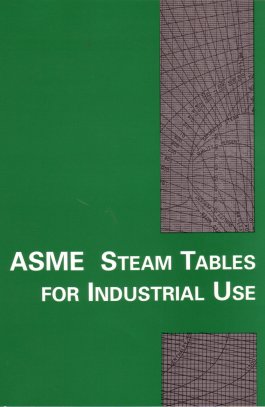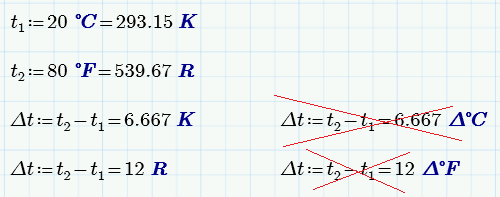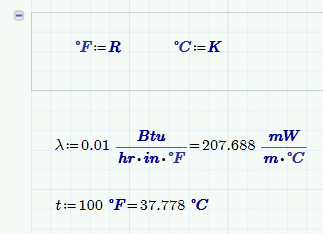Community Tip - Stay updated on what is happening on the PTC Community by subscribing to PTC Community Announcements. X
- Subscribe to RSS Feed
- Mark Topic as New
- Mark Topic as Read
- Float this Topic for Current User
- Bookmark
- Subscribe
- Mute
- Printer Friendly Page
Temperature in Mathcad
- Mark as New
- Bookmark
- Subscribe
- Mute
- Subscribe to RSS Feed
- Permalink
- Notify Moderator
Temperature in Mathcad
- Labels:
-
Other
Accepted Solutions
- Mark as New
- Bookmark
- Subscribe
- Mute
- Subscribe to RSS Feed
- Permalink
- Notify Moderator
One compromise:

ELSID wrote:
Your not quite a diamond member ... YET
Yes you can do what you've done, BUT (i know, I just negated everything before the but), you can no longer use C or F as they are now "re-defined".
The definition in Mathcad of using DT works. As for your re-definition, the built-in DT values are DC=K and DF=(5/9)K and I can continue to use C or F without issues. I cannot emphasize enough that this works with papers, especially to clients and QA/QC staff who may not be as technically competent. They understand D (delta) is a change and the units after is universally accepted.
If this is a petition for PTC to eliminate the DT "unit as it currently stands, I vote to keep the status quo as my pee-wee non- PhD, diamond member, or hero of the month brain understands it clearly!
Maybe you're over thinking it Valery
I often find that educated engineers and good students usually a) know what it is default, which is widely used in engineering, c) know what is temperature and c) have ... sense of humor ![]()
In the book from NIST and ASME (see the cover below) I see only °F but not deltaF in thermal conductivity unit and °R but not deltaF as entropy or (isobaric or isohoric) heat capacity units!

And second and last!
The main topic of this my messege http://communities.ptc.com/docs/DOC-3251
was not "conservative American and British people" but two temperature scale - ITS-68 and ITS-90.
PS
An old joke.
Father and son walking through Paris.
- Dad, who built the tower?
- Engineer Eiffel.
- It's like my mother - an engineer?
- No, my son, your mother is a lead engineer!
![]()
- Mark as New
- Bookmark
- Subscribe
- Mute
- Subscribe to RSS Feed
- Permalink
- Notify Moderator
Valery,
This is a "unit" in 14 and 15 unter temperature as well. I use it all the time. It turns temperature into a liniar problem. On my Heat Transfer coefficients or equations, the "text book" formulas typically show a "change in temperature" by using the degrees F or degrees C. In my opinion, showing it as delta or change of temperature is correct. Scroll through some of my worksheets and you will see what I mean.
Example: 100C - 80C needs to equal 20C and not -253.15C. DT is a change in temperature. If we use the "standard "degree F", the result is clearly wrong.
Maybe a better request is to lump miscelaneous factors and scale units (e.g. DT, dB) into it's own category since they are not a true unit. In this case, the deltas are obviously defined as DC=K (kelvin) and DF=(5/9)K.
- Mark as New
- Bookmark
- Subscribe
- Mute
- Subscribe to RSS Feed
- Permalink
- Notify Moderator
I agree with El Sid. I don't see how you can eliminate the deltaT units. The fact is, T and deltaT are different things, and therefore must be represented differently.
- Mark as New
- Bookmark
- Subscribe
- Mute
- Subscribe to RSS Feed
- Permalink
- Notify Moderator
Richard Jackson wrote:
I agree with El Sid. I don't see how you can eliminate the deltaT units. The fact is, T and deltaT are different things, and therefore must be represented differently.
K (Kelvin) and °R (Rankin degree) but not delta°C or delta°F.
I have asked one unit expert in NIST (!!!) why in USA you use Btu/(lb °R) for entropy and Btu/(hr ft °F) for thermal conductivity. But in Europe we use kJ/(kg K) and W/(m K). Only in old old books W/(m °C).
This expert replied me that it connected with the "conservatism of the American people" ![]()
- Mark as New
- Bookmark
- Subscribe
- Mute
- Subscribe to RSS Feed
- Permalink
- Notify Moderator
Richard Jackson wrote:
I agree with El Sid. ...
I agree also, but I sympathise with Valery as the Mathcad notation for deltaT is awful! I was taught to use K, °C, °F ... etc. for actual temperatures, and degK, degC, degF etc for temperature differences i.e. no ° in the temperature difference units and the letters deg, not the greek delta (which was reserved for deltaT). For example, one might have T = 5°C and deltaT = 5degC, say. This seems much 'cleaner' to me (though I don't think it's in any international standards).
Alan
- Mark as New
- Bookmark
- Subscribe
- Mute
- Subscribe to RSS Feed
- Permalink
- Notify Moderator

But what will say about it "the conservative American and British people"?!
And why not (one sheet for Mathcad Mad House - http://communities.ptc.com/groups/mathcad-paradoxes😞

- Mark as New
- Bookmark
- Subscribe
- Mute
- Subscribe to RSS Feed
- Permalink
- Notify Moderator
Who am I to "argue" with several PhD's, hero's of the month, and Diamond helpers ![]() . The notation is funky BUT it works and makes things understandable for most of my audience.
. The notation is funky BUT it works and makes things understandable for most of my audience.
Valery Ochkov wrote:
...Btu/(hr ft °F) for thermal conductivity.
This is a great example of why I use Btu/(hr ft D°F) for thermal conductivity. It "linearizes" the math. I have found that using the "Delta" with the temperature in familiar units is less confussing than switching to Rankin/Kelvin, especially when talking to clients (not always engineers/scientists). In summary, people do not deal in absolute temperature units. It is, however, generally accepted that "Delta" means change the world/clients/laypeople understand °C/°F.
- Mark as New
- Bookmark
- Subscribe
- Mute
- Subscribe to RSS Feed
- Permalink
- Notify Moderator
ELSID wrote:
Who am I to "argue" with several PhD's, hero's of the month, and Diamond helpers
. The notation is funky BUT it works and makes things understandable for most of my audience.
Valery Ochkov wrote:
...Btu/(hr ft °F) for thermal conductivity.
This is a great example of why I use Btu/(hr ft D°F) for thermal conductivity. It "linearizes" the math. I have found that using the "Delta" with the temperature in familiar units is less confussing than switching to Rankin/Kelvin, especially when talking to clients (not always engineers/scientists). In summary, people do not deal in absolute temperature units. It is, however, generally accepted that "Delta" means change the world/clients/laypeople understand °C/°F.
From "several PhD's, hero's of the month, and Diamond helpers" to ""conservative American and British people" ![]() :
:

- Mark as New
- Bookmark
- Subscribe
- Mute
- Subscribe to RSS Feed
- Permalink
- Notify Moderator
Your not quite a diamond member ... YET![]()
Yes you can do what you've done, BUT (i know, I just negated everything before the but), you can no longer use C or F as they are now "re-defined".
The definition in Mathcad of using DT works. As for your re-defenition, the built-in DT values are DC=K and DF=(5/9)K and I can continue to use C or F without issues. I cannot emphasize enough that this works with papers, especially to clients and QA/QC staff who may not be as technically competant. They understand D (delta) is a change and the units after is universally accepted. ![]()
If this is a petition for PTC to eliminate the DT "unit as it currently stands, I vote to keep the status quo as my pee-wee non- PhD, diamond member, or hero of the month brain understands it clearly!
Maybe you're over thinking it Valery ![]()
- Mark as New
- Bookmark
- Subscribe
- Mute
- Subscribe to RSS Feed
- Permalink
- Notify Moderator
One compromise:

ELSID wrote:
Your not quite a diamond member ... YET
Yes you can do what you've done, BUT (i know, I just negated everything before the but), you can no longer use C or F as they are now "re-defined".
The definition in Mathcad of using DT works. As for your re-definition, the built-in DT values are DC=K and DF=(5/9)K and I can continue to use C or F without issues. I cannot emphasize enough that this works with papers, especially to clients and QA/QC staff who may not be as technically competent. They understand D (delta) is a change and the units after is universally accepted.
If this is a petition for PTC to eliminate the DT "unit as it currently stands, I vote to keep the status quo as my pee-wee non- PhD, diamond member, or hero of the month brain understands it clearly!
Maybe you're over thinking it Valery
I often find that educated engineers and good students usually a) know what it is default, which is widely used in engineering, c) know what is temperature and c) have ... sense of humor ![]()
In the book from NIST and ASME (see the cover below) I see only °F but not deltaF in thermal conductivity unit and °R but not deltaF as entropy or (isobaric or isohoric) heat capacity units!

And second and last!
The main topic of this my messege http://communities.ptc.com/docs/DOC-3251
was not "conservative American and British people" but two temperature scale - ITS-68 and ITS-90.
PS
An old joke.
Father and son walking through Paris.
- Dad, who built the tower?
- Engineer Eiffel.
- It's like my mother - an engineer?
- No, my son, your mother is a lead engineer!
![]()
- Mark as New
- Bookmark
- Subscribe
- Mute
- Subscribe to RSS Feed
- Permalink
- Notify Moderator
I don't recall ever being taught any particular notation for this. If you want degC and degF you could easily define some new functions though.
- Mark as New
- Bookmark
- Subscribe
- Mute
- Subscribe to RSS Feed
- Permalink
- Notify Moderator
Richard Jackson wrote:
... If you want degC and degF you could easily define some new functions though.
Of course, and I often do, but my main point was that the Mathcad notation is ugly (in my view)!
Valery's comparison with lengths and differences in lengths seems invalid to me - lengths and differences in lengths are both the same type of quantity, temperatures and temperature differences are not.
Also, Valery notes that "I often find #that educated engineers and good students usually a) know what it is default ..., ". I've also found that this is usually the case when people use T for temperature; but sometimes one sees theta used for temperatures and sometimes for temperature differences. In this case it can be much less obvious and the potential for confusion exists.
Alan
- Mark as New
- Bookmark
- Subscribe
- Mute
- Subscribe to RSS Feed
- Permalink
- Notify Moderator
Valery's comparison with lengths and differences in lengths seems invalid to me - lengths and differences in lengths are both the same type of quantity, temperatures and temperature differences are not.
If all lengths were measured relative to a single fixed point in space, so that there would be an "absolute zero" of length, then lengths and length differences would be different ![]()
- Mark as New
- Bookmark
- Subscribe
- Mute
- Subscribe to RSS Feed
- Permalink
- Notify Moderator
Richard Jackson wrote:
Valery's comparison with lengths and differences in lengths seems invalid to me - lengths and differences in lengths are both the same type of quantity, temperatures and temperature differences are not.
If all lengths were measured relative to a single fixed point in space, so that there would be an "absolute zero" of length, then lengths and length differences would be different
I heard a legend.
The Germans and Swiss have built a bridge across Rhine.
The Germans built a bridge from one side of the river, and the Swiss - on the other.
The bridge converged on the middle of the river with a difference... of 1 m
Why?
Germans have the zero point - the North Sea, and the Swiss - the Mediterranean Sea!
- Mark as New
- Bookmark
- Subscribe
- Mute
- Subscribe to RSS Feed
- Permalink
- Notify Moderator
- Mark as New
- Bookmark
- Subscribe
- Mute
- Subscribe to RSS Feed
- Permalink
- Notify Moderator



